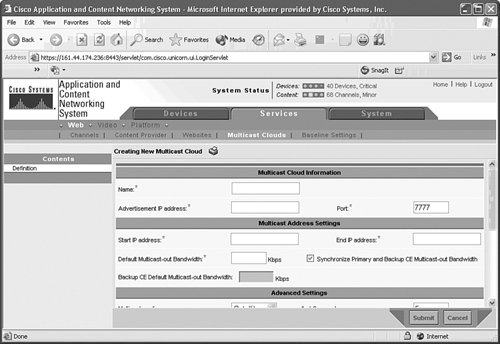Configuring Content Pre-Positioning
| As you learned previously, you can configure your root-CE to distribute the content that you want to pre-position using either multicast-push or unicast-pull. Multicast-Push Distribution TreesBecause multicast was designed for real-time applications with high tolerance to packet loss, User Datagram Protocol (UDP) was chosen for the transport protocolmulticast cannot run over TCP. However, file transfers have no tolerance for lost packets and therefore require a reliable transmission mechanism. To reliably distribute content to the CEs registered to the channel, you can enable Pragmatic General Multicast (PGM) on your CEs. As you learned in Chapter 5, "IP Multicast Content Delivery," PGM is a reliable multicast protocol. The root CE sends the channel content to a multicast address that you define on the CDM, which registered CEs join to to receive the channel content. Note To distribute with IP multicast, you must enable all your routers within the ACNS network with IP multicast. You can also enable the PGM router-assist feature to minimize negative acknowledgement (NAK) and NCF flooding. To configure multicast in your ACNS network, you must create a multicast cloud. Figure 14-12 illustrates how to configure a multicast cloud. Figure 14-12. Configuring a Multicast Cloud Unicast-Pull Distribution TreesLike multicast-push trees, the concept of distribution trees can also be used for pre-positioning content in a unicast-only environment. The unicast distribution trees are created from the location trees that you created previously. With unicast-pull distribution, each location is elected a location leader. The location leader unicast-pulls the channel's content from the forwarder of its parent location. The leader of a location is in turn the forwarder for other CEs within its location. The forwarder for child locations can be any of the CEs within the location. For example, in Figure 14-13, the receiver CE in Location 4 determines the forwarder in Location 2 and establishes a TCP connection, over which it sends the request. The forwarder in Location 2 then establishes a TCP connection with the location leader in Location 2 and sends the request. The location leader in Location 2 determines the forwarder in Location 1, which happens to be the root CE in this example, and receives the requested object. The forwarders then forward the requested object down the unicast tree using the existing TCP connections established previously. Figure 14-13. Unicast Distribution Trees You can influence which CEs become the forwarders and location leaders from the CDM, as Figure 14-14 illustrates. Figure 14-14. Configuring Location Forwarder Probability and Leader Preference |
EAN: 2147483647
Pages: 178